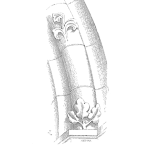
The new deepwater expansion joint design meets company requirements for factors of safety but cannot comply with ASME Section VIII load factors. How does the OEM engineering manager proceed?
Your Reliability Engineering Professional Development Site
Find all articles across all article series listed in reverse chronological order.

The new deepwater expansion joint design meets company requirements for factors of safety but cannot comply with ASME Section VIII load factors. How does the OEM engineering manager proceed?
by Christopher Jackson Leave a Comment

I often start teaching my reliability engineering courses … by focusing on other reliability engineering courses. Why? Because they exemplify what is wrong with how most ‘reliability experts’ go about convincing others to take reliability seriously.
A typical reliability engineering course will start with images of disaster. A Chernobyl here. A Fukushima there. A crashed airplane. The Tacoma Narrows Bridge. Lots of other atrocities that happen when we don’t do reliability engineering properly.
by Robert (Bob) J. Latino Leave a Comment

Where does ‘failure’ come from? Why do some things not go as we planned? When bad things happen, at that time, it can be chaotic and appear very complex. Often, in hindsight (when the urgency has faded), we find that good people made bad decisions at that time. Most of the time such failures were not complicated and we find that most likely, anyone else put in the same position, would have made the same decision. So why do things not always go as planned?
by James Kovacevic Leave a Comment
 How many times has an asset been installed or commissioned, only to have it fail in a few days or months when it should have lasted even longer? If you look at the study by Nowlan & Heap, they have found that only 11% of failures are age related, so when is happening with these assets? The answer… comes down to poor installation practices.
How many times has an asset been installed or commissioned, only to have it fail in a few days or months when it should have lasted even longer? If you look at the study by Nowlan & Heap, they have found that only 11% of failures are age related, so when is happening with these assets? The answer… comes down to poor installation practices.
[Read more…]
by Alex Williams Leave a Comment

From demonstrating compliance and ensuring safety to maintaining assets and increasing productivity, food manufacturing maintenance managers have their work cut out for them. Thankfully, computerized maintenance management software (CMMS) can streamline processes and improve maintenance operations for the food manufacturing industry. Read on to learn how food manufacturing CMMS software can significantly benefit your organization.
[Read more…]by Greg Hutchins Leave a Comment

Today, there is a lot of attention and discussion regarding future work. How will new technology impacts jobs? What will it look like? What jobs will be eliminated? What will the future jobs look like? How should I prepare?
It is difficult to identify with any accuracy what jobs will be eliminated and what new jobs will be available. My advice is to focus on skills. What skills will help ensure job security in the future? This is the real question.
by James Reyes-Picknell Leave a Comment

Like the human body, our plant and mobile equipment will break down if it’s not looked after. If we exercise and push ourselves harder, we gain strength. Unlike our biological bodies that can self-repair, our physical plants and mobile equipment do NOT strengthen if we overload them. Yes, they will tolerate some abuse but not for long. Machinery, unlike biological organisms, can not recover from damage on its own. It needs a bit of basic care. Basic care is all about taking care of our physical assets so they continue to do what we need them to do. Take care of their fluids (e.g.: oils, coolants), keep them from running hot (e.g.: clean heat transfer surfaces like cooling fins), and keep them free of contaminants that damage their insides (e.g.: keep moisture and dirt out). In the “Uptime Pyramid of Excellence,” the pinnacle is “Choosing Excellence”. That choice implies an active application of all of the model’s components. It’s a journey, not a destination.
by Steven Wachs Leave a Comment

In this week’s article entry, we discuss some guidelines for conducting an experiment. As we discussed in an earlier post, planning the study is critical for a successful outcome. A good plan makes the conduct of the study straightforward.
Below are some key aspects of conducting the study: [Read more…]
by George Williams Leave a Comment

ASQ Reliability Division published “Credible Reliability Prediction” (CRP) in 2003. Harold Williams, Reliability Division monograph series editor, wrote, “[CRP] …delineates statistical methods that effectively extend MTBF prediction to complex, redundant, dependent, standby, and life-limited systems… This is the first text that describes a credible method of making age-specific reliability predictions…. This monograph presents insights and information inspired by real applications and [still] not covered in contemporary reliability textbooks.”
by Christopher Jackson Leave a Comment

I (like most of us) try to keep learning about stuff. And this includes (on occasion) listening to guys like Simon Sinek who has made a name for himself as an inspirational speaker and author. I learn a lot from some of his stuff. Most people like Simon are skilled at simplifying fundamentally ‘good’ ideas and principles into really simple messages that are easy to break through our sometimes cluttered brains.
by Robert (Bob) J. Latino Leave a Comment

Trick question, it’s neither!
When we hear people use the term ‘error’ it is normally associated with being the cause of some type of bad outcome. We hear it all the time with airline accidents where they conclude ‘pilot error’.
‘Error’ is neither the cause nor the undesirable outcome! Let’s see why.
Is the only type of error a ‘human error’? I struggled to think of an ‘error’ that is not a human error, so I asked if others could think of something else. I would like to thank Dr. Peter Elias who commented that errors can occur in biologic processes, such as RNA and DNA replication or messaging. He also cited non-human animals make errors all the time as well.
by James Kovacevic Leave a Comment
 A major asset is being installed, and the asset is vital to the success of a brand new, high-profit product being introduced to the site. This product is enough to keep the site operational for many years to come. The installation of the asset is critical, and there is extensive prep work to eliminate soft foot, ensuring the base is flat (using geometric measurement) and that the asset is aligned properly.
A major asset is being installed, and the asset is vital to the success of a brand new, high-profit product being introduced to the site. This product is enough to keep the site operational for many years to come. The installation of the asset is critical, and there is extensive prep work to eliminate soft foot, ensuring the base is flat (using geometric measurement) and that the asset is aligned properly.
[Read more…]
by Greg Hutchins Leave a Comment

“Well, there was the kidnapping. Is that something you’re interested in?”
It was our last day of a week-long site security survey. We were meeting with the site manager to wrap up our visit but this was the first time we had heard anything about something as serious as this.
So yes, a kidnapping was something we were very, very interested in learning about….
by James Reyes-Picknell Leave a Comment

There are two things you must do in a successful maintenance program: be good at doing your work, and only do the right work. Both are needed to deliver asset reliability – the cornerstone of sustainable, safe and quality production levels. In chasing reliability many turn to programs for defining the right work, yet many of those efforts will fail. Why? Poor or ineffective planning. The greatest benefits come from defining the right maintenance program using RCM and then implementing with quality work and on schedule.
Failure of reliability improvement programs can be from poor execution of RCM, but more often it is the result of something more basic. They are stuck in a culture of unreliability. [Read more…]